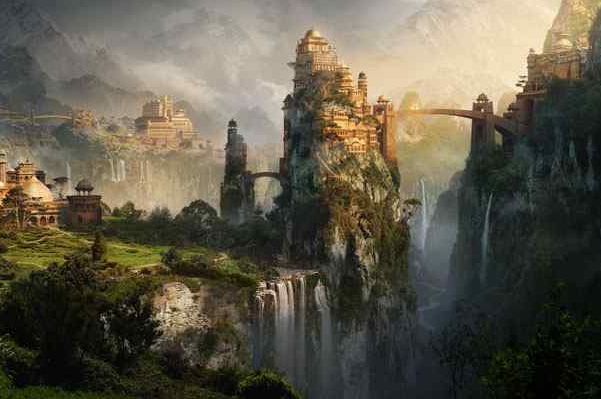
- Shangri-La is a fictional place described in the 1933 novel Lost Horizon by British author James Hilton. In the book, “Shangri-La” is a mystical, harmonious valley, gently guided from a lamasery, enclosed in the western end of the Kunlun Mountains. Shangri-La has become synonymous with any earthly paradise but particularly a mythical Himalayan utopia—a permanently happy land, isolated from the outside world. In the novel Lost Horizon, the people who live at Shangri-La are almost immortal, living years beyond the normal lifespan. The word also evokes the imagery of exoticism of the Orient. The story of Shangri-La is based on the concept of Shambhala, a mystical city in the Tibetan Buddhist tradition.

- Lost Horizon is a 1933 novel by English writer James Hilton. It is best remembered as the origin of Shangri-La, a fictional utopian lamasery high in the mountains of Tibet.

- Several locations in the Buddhist Himalaya between northern India and Tibet have claimed to be the basis for Hilton’s legend, largely to attract tourism. In China, Tao Qian of the Jin Dynasty described a Shangri-La in his work Story of the Peach Blossom Valley (Chinese: 桃花源記, pinyin: Táohuā Yuán Jì)


- n modern China, the Zhongdian country was renamed to 香格里拉县 (Xiānggélǐlā, Shanri-La in Chinese) in 2001, to attract tourists. The legendary Kun Lun Mountains in Tibet offer other possible Shangri-La valleys.
- Being an isolated green valley surrounded by mountains, enclosed on the western end of the Himalayas, it closely matches the description in the novel. A Shangri-La resort in the nearby Skardu valley is a popular tourist attraction.”]
![A popularly believed inspiration for Shangri-La is the Hunza Valley in northern Pakistan, close to the Tibetan border, which Hilton visited a few years before Lost Horizon was published.[2] Being an isolated green valley surrounded by mountains, enclosed on the western end of the Himalayas, it closely matches the description in the novel. A Shangri-La resort in the nearby Skardu valley is a popular tourist attraction.](http://img2.travelblog.org/Photos/9278/104051/f/702050-Passu-Hunza-Valley-Pakistan-0.jpg)
- A popularly believed inspiration for Shangri-La is the Hunza Valley in northern Pakistan, close to the Tibetan border, which Hilton visited a few years before Lost Horizon was published

- Today, various places claim the title, such as parts of southern Kham in southwestern Yunnan province, including the tourist destinations of Lijiang and Zhongdian. Places like Sichuan and Tibet also claim the real Shangri-La was in its territory. In 2001, Tibet Autonomous Region put forward a proposal that the three regions optimise all Shangri-la tourism resources and promote them as one. After failed attempts to establish a China Shangri-la Ecological Tourism Zone in 2002 and 2003, government representatives of Sichuan and Yunnan provinces and Tibet Autonomous Region signed a declaration of cooperation in 2004. Also in 2001, Zhongdian County in northwestern Yunnan officially renamed itself Shangri-La County.
- Bhutan, which was until now isolated from outside world and has its unique form of Tibetan Buddhism, has been hailed as the last Shangri-La. Another place that has been thought to have inspired the concept of Shangri-La is the Yarlung Tsangpo Canyon.

- TV Presenter and Historian Michael Wood suggests that the legendary Shangri-La is the abandoned city of Tsaparang and its two great temples that were once home to the Kings of Guge in modern Tibet.

- Later on, Chinese Government assert formally that this mysterious place is a small town of Yunnan Province known as Zhong Dian in 2001 through investigate and verify (renamed as Shangri-la county now). Shangri-la is the fairyland of human world, there is extraordinary beautiful scenery, she is as beautiful as young Chinese girl.

Shambhala “To Conway, seeing it first, it might have been a vision . . . It was indeed a strange and incredible sight. A group of colored pavilions clung to the mountainside with the . . . chance delicacy of flower-petals impaled upon a crag. It was superb and exquisite. An austere emotion carried the eye upward from milk-blue roofs to the gray rock bastion above . . . Beyond that, in a dazzling pyramid, soared the snow slopes of Karakal.” Such was Conway’s first glimpse of Shangri-La, the hidden lamasery in Tibet as described in James Hilton’s novel, Lost Horizon.

No comments:
Post a Comment